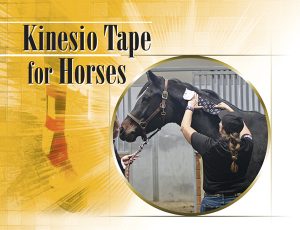Kinesio Tape for Horses
Click here to read the complete article
90 – March/April, 2022
Kinesiology is the study of body movement—in humans or animals—and addresses the physiological, biomechanical, and psychological dynamic principles and mechanisms of movement. As a science, it also uses the principles of traditional Chinese medicine to evaluate health and imbalances—and tries to test the flow of energy in the acupuncture meridians of the body, through isolating certain muscle groups—allowing assessment of the functioning of all the major body systems.
In recent decades, various treatments and rehab methodologies have been created using these principles. For instance, the Kinesio Taping® Method is a rehabilitative technique designed to facilitate the body’s natural healing process by providing more soft tissue manipulation. This mimics the effects of massage while providing support and stability to the muscles and joints without restricting their range of motion.
HOW IT BEGAN
Mona Angel, General Manager, Kinesio Group, Albuquerque, NM says the Kinesio® tape and method for using it was developed by Dr. Kenzo Kase (a Japanese chiropractor) in the early 1970s to provide a non-pharmaceutical method to alleviate his human patients’ pain in between their appointments. He was born in Japan in the 1940s, and as a child suffered from pneumonia, tuberculosis, kidney infections and allergies. Physical fragility kept him from participating in physical education classes.
He learned firsthand about the power of healing touch from his grandmother, a Japanese healer who used herbal remedies, acu-puncture and moxibustion techniques. Moxibustion is a traditional Chinese medicine technique that involves burning moxa (a cone or stick made of ground mugwort leaves) on or near the body’s meridians and acupuncture points. Practitioners believe that the resulting heat helps stimulate these points and improves the flow of energy in the body.
After graduating from chiropractic school in Chicago, Dr. Kase continued to combine his education in mainstream and traditional medical techniques and philosophies. During the 1970s, while treating elderly osteoarthritis patients, he became frustrated with the limited treatment methods available. Even though he could get the patient’s joint into positions that were less painful and resembled normal use, after these patients went home, they’d usually return to their old habits and painful positions. He wanted the treatments to extend beyond his patients’ office visits so he tried to find a way to send his hands home with them.
Click here to read the complete article
90 – March/April, 2022











